BARCELONA – Alzheimer’s disease genetic risk status didn’t influence positive findings of the investigational monoclonal antibody, BAN2401, in a post hoc analysis of a phase 2 study’s secondary endpoint, Eisai said in a report released during the Clinical Trials on Alzheimer’s Disease conference.
In fact, according to the new analysis, the positive data presented last summer probably underestimated the molecule’s benefit to homozygous carriers of the apolipoprotein E epsilon-4 (APOE4), Chad Swanson, PhD, said at the meeting.
The new data cut was based on a small fraction of the 856 patients with early Alzheimer’s disease (AD) who were enrolled in Study 201: 10 APOE4 carriers and 69 noncarriers who completed 18 months on infusions of BAN2401 at 10 mg/kg biweekly, the only beneficial dose. The subanalysis determined that carriers benefited much more than did noncarriers on the three clinical measures, said Dr. Swanson, senior director of neurology clinical research at Eisai, and the study’s director:
- The Alzheimer’s Disease Composite Score (ADCOMS), a new measure of subtle cognitive changes in early disease: Carriers, 63% less decline than placebo vs. 7% less in noncarriers.
- Alzheimer’s Disease Assessment Scale-cognitive subscale (ADAS-Cog): Carriers, 84% less decline than placebo vs. 43% less in noncarriers.
- Clinical Dementia Rating-Sum of Boxes (CDR-SB): Carriers, 60% less decline than placebo vs. a 7% worsening in noncarriers.
To strengthen the power of the analysis, Dr. Swanson pooled data from the entire 18 months of both the 10 mg/kg biweekly and the next-highest dose (10 mg/kg monthly). This increased the numbers to 273 carriers and 141 noncarriers who had at least one exposure to the antibody.
He said this corrected the APOE4 imbalance and showed a 25% slowing of ADCOMS decline in carriers, a 6% slowing in noncarriers, and a 21% slowing overall, relative to placebo.
The somewhat counterintuitive findings took even copresenter Jeffrey L. Cummings, MD, by surprise.
“I would have hypothesized a greater effect in noncarriers than carriers, but that’s the great thing about data – they challenge our assumptions,” said Dr. Cummings, director of the Center for Neurodegeneration and Translational Neuroscience and director emeritus of the Cleveland Clinic Lou Ruvo Center for Brain Health in Las Vegas and a consultant for both Eisai and Biogen, the company’s BAN2401 developmental partner. He postulated that APOE4-driven differences in plaque composition could have contributed to the observed benefit. “I think this also points to a very interesting biology that we don’t yet know. The plaque compactness is different, the distribution of diffuse plaques is different. This will bear a lot of additional analysis.”
Study 201 randomized patients with early Alzheimer’s to up to 18 months of treatment with placebo or infusions of BAN2401 at 2.5 mg/kg biweekly, 5 mg/kg monthly, 5 mg/kg biweekly, 10 mg/kg monthly, or 10 mg/kg biweekly. It had two unusual design features. First, patents were allocated to treatment arms by a Bayesian algorithm. The computer program examined results after every 50 enrollees and then allocated new subjects to what were, at that point, the most effective two doses. Additionally, the 18-month study was designed with a potential 12-month exit point, if computer modeling showed that it had at least an 80% probability of reaching at least a 25% cognitive benefit. In December, Eisai announced that the study hit just a 64% probability, missing the primary endpoint. But because Eisai felt the numbers were moving in the right direction, it continued with the additional 6 months of treatment, as allowed for in the study design, and then reanalyzed results with conventional statistics.
Thus, the successes reported at the Alzheimer’s Association International Conference in July and reanalyzed at CTAD, were secondary cognitive and functional outcomes.
Partway through the trial, a European regulatory body became alarmed at the rate of amyloid-related imaging abnormalities (ARIA) in the APOE4 carriers and excluded them from the highest-dose group. This meant that carriers comprised about 70%-80% of every unsuccessful treatment arm but just 29% of the successful one. The unbalanced randomization caused July’s skepticism. The CTAD subanalysis didn’t entirely alleviate it, and several acclaimed Alzheimer’s researchers gave it voice.
“You showed no difference in placebo rates of decline, but an increased benefit in the E4 carriers, which was really interesting,” said Reisa Sperling, MD, of Brigham and Women’s Hospital, Boston. “One difference in the E4 carriers was their rate of ARIA and how long they stayed in the study. How did you account for these issues in this analysis?”
“We didn’t specifically look at that kind of question,” Dr. Swanson said. “I think we feel that we actually see effects in both carriers and noncarriers, and we are still exploring the data and will keep looking through them to see what we can find.”
Gil Rabinovici, MD, also expressed some reservations.
“I agree that the post hoc analyses are encouraging, but I wouldn’t say they alleviate the concern when you have such a dramatic imbalance in a core feature of this disease, like APOE4 between the placebo and the high-dose group,” said Dr. Rabinovici, the Edward Fein and Pearl Landrith Endowed Professor in Memory & Aging at the University of California, San Francisco. “The people on this panel know far more than I do of the pitfalls of these kinds of analyses. We really need to see true randomization to put this issue to rest.”



